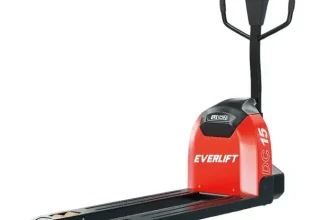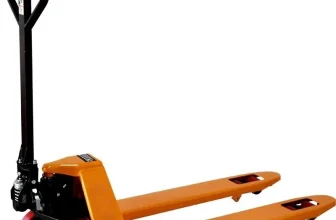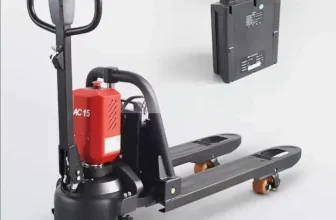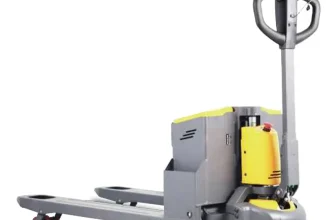Pallet jacks, also known as pallet trucks, pallet pumps or jiggers, are quintessential tools in the material handling industry. They are designed specifically to move and lift pallets – flat structures used in the transport of goods – in a multitude of environments, ranging from warehouses to retail floors.
On a basic level, a pallet jack consists of a pair of forks that slide under the pallet, a hydraulic jack that raises and lowers the load, and a handle that is used to steer. To use it, the operator slides the forks into the openings of a pallet, and then pumps the handle up and down. This action raises the pallet off the ground, allowing it to be safely and efficiently moved.
Whether manual or electric, pallet jacks are essential for businesses that require the quick and safe transport of heavy goods around a warehouse or other spaces. As simple as they may seem, pallet jacks play a vital role in facilitating everyday logistics and significantly enhancing productivity. Without them, the tasks of loading, unloading, and transportation would be considerably more labor-intensive and time-consuming.
Importance in warehouse operations
Pallet jacks play a crucial role in warehouse operations, acting as the backbone of the material handling industry. They offer a safe and efficient method of transporting heavy goods from one place to another with minimum effort. From loading and unloading trucks to moving items around the warehouse floor, pallet jacks significantly lower the physical strain on workers, thereby reducing the risk of injuries and boosting productivity. In a busy warehouse environment where speed and efficiency are paramount, the usefulness of pallet jacks cannot be overstated. They allow smooth and swift movement of goods, vastly improving the warehouse operations by enabling heavier loads to be transported faster than manual handling. Undeniably, pallet jacks are among the most fundamental pieces of equipment in ensuring the seamless operation of warehouses.
Understanding Self Loading Pallet Jacks
Definition of self loading pallet jacks
Self-loading pallet jacks, as the name implies, are material handling tools designed to automatically lift and transport loaded pallets, without the necessity of manual intervention for the loading process. Much like their traditional counterparts, these self-loading pallet jacks have forks that slide under the pallets. However, they come equipped with a built-in hydraulic system that lifts the pallet off the floor once the forks are correctly positioned. This mechanism allows the operator to effortlessly move the loaded pallet to its intended location. The self-loading functionality of these jacks exemplifies innovation in warehouse and material handling equipment, further enhancing efficiency and productivity in various industrial settings.
How self loading pallet jacks function
At the heart of the self loading pallet jack’s operation is its automatic lifting and lowering mechanism, radically different from manually operated traditional pallet jacks. A self loading pallet jack utilizes an advanced hydraulic system to lift or lower loaded pallets. To use it, the operator places the fork prongs at either end of a pallet. Upon a command, the machine takes over, engaging its self loading feature and raising the pallet usually around three inches off the ground, enough to transport pallets over even floor surfaces.
Another significant feature of the self loading pallet jack is its ability to automatically adjust to the size of the pallet. This means it can accommodate numerous pallet sizes, increasing versatility in a diverse warehouse environment. After transportation, the self loading pallet jack, again through operator supervision, carefully lowers its load at the desired location. This is made possible by the reverse operation as the automatic hydraulic system engages to gracefully ease the loaded pallet onto the floor.
Overall, the function of self loading pallet jacks removes the burden of manual lifting from the operator, providing a seamless process from pallet pick-up to delivery.
Differentiating traditional pallet jacks from self loading ones
Traditionally, pallet jacks, also known as pallet trucks, are manually operated devices used to lift and move pallets within a warehouse setting. They consist of two forks that slide under the pallet, a hydraulic jack to raise it, and a handle for pushing or pulling. The worker, often referred to as the operator, manually aims the forks into the pallet’s open slots, pumps the handle to elevate the pallet off the ground, and then pushes or pulls the jack to its destination.
On the other hand, the self-loading pallet jack is a modern version that streamlines this process, making it as effortless as possible. Unlike the traditional jack, it has an automatic system which can load and unload pallets without significant human power. The forks are designed to open and close automatically, clasping onto the pallet and lifting it as required. Once the pallet is secure, the operator merely steers the pallet to its destination.
One of the fundamental differences between these two types of jacks lies in the fact that the self-loading pallet jack reduces the need for manual labor. Manual pallet jacks require physical strength and effort from the operator to load, lift, and move the pallet. In contrast, self-loading jacks, with their automatic mechanisms, take care of these steps, leaving the operator to essentially guide the machine.
Another key difference is that self-loading pallet jacks are often battery-powered, which allows them to operate for extended periods and handle higher weight capacities than their manual counterparts. These innovations make self-loading pallet jacks an increasingly popular choice for many industries.
In summary, while traditional and self-loading pallet jacks perform the same basic function, the latter takes advantage of advanced technology to minimize manual labor and improve overall efficiency.
Key Features of Self Loading Pallet Jacks
Load capacity
Self-loading pallet jacks are designed to carry large loads with a typical weight capacity ranging from 1500 to 2000 kilograms, although heavier-duty models can support loads of up to 3000 kilograms. This load capacity is much higher than that of traditional manual pallet jacks which typically can support loads up to 1000 kilograms. This feature allows the self-loading pallet jack to handle even the heaviest goods with ease, enabling more products to be moved in a single trip. However, it is crucial to ensure that the loads are evenly distributed on the forks to maintain the stability of the equipment during operation.
Automatic mechanism
The automatic mechanism is a significant feature of self-loading pallet jacks that sets them apart from traditional manual jacks. Equipped with automated functions, these jacks are designed to load and unload pallets without the need for direct manual input throughout the process. They come with electronic controls that allow operators to manage the loading and unloading procedures with ease and precision. This technology helps to alleviate the burden of manual lifting, reducing the potential for operator fatigue and injury. The self-loading pallet jack’s automatic system enables quicker, smoother and more accurate operations, making it a crucial tool for industries seeking to enhance efficiency, safety, and productivity.
Size and maneuverability
One of the standout features of a self loading pallet jack is its size and maneuverability. Compared to traditional forklifts or other loading machines, self loading pallet jacks are designed to be compact and easy to manage. The smaller size and design make these devices incredibly advantageous in environments that have limited space like small warehouses, retail stores, or tight loading docks.
Despite this compact size, these pallet jacks do not compromise on their ability to maneuver through tight angles and corners. They are built for navigating through narrow pathways, enabling easy transportation of goods within a warehouse. The product’s integrated steering function and responsive handle control contribute to improved maneuverability, allowing users to make quick and effortless adjustments during operation. The turning radius on these devices tends to be rather small too, providing flexibility in the way they are used and driven. This ease of maneuverability reduces the risk of accidents, damage to goods, or any disruption to workflow.
In essence, the balance of compact size and high maneuverability makes self loading pallet jacks an efficient tool in logistics and warehouse management, where space optimization is key.
Safety features
Self Loading Pallet Jacks come equipped with various safety features designed to reduce accidents and ensure safe operation. A critical element of these safety features is the presence of emergency stop buttons. The buttons are typically installed in easily accessible locations, enabling operators to immediately halt the machine when confronted with unexpected situations.
Another common safety feature you’ll find is the anti-slip platform. This feature dramatically reduces the risk of personnel slipping during loading and unloading operations, further minimizing the likelihood of on-site injuries. The anti-tilt design of these jacks can also prevent the loaded goods from turning over, especially when carrying heavy loads.
Moreover, self loading pallet jacks often include brake systems that automatically engage when the operator releases the control. They may also offer a horn or some type of audible alert system to alert others in the immediate vicinity of the machine’s operation.
Lastly, some models may have safety screens or guards installed. These are designed to protect the operator and other people around the workspace from accidental contact with any moving components of the machine.
Keep in mind that while these safety features greatly enhance the safe operation of these machines, they do not replace the need for proper training and adherence to safety protocols at the workplace.
Benefits of Using Self Loading Pallet Jacks
Increased productivity
One of the major benefits of using self loading pallet jacks lies in their power to significantly increase productivity. These machines are built to perform tasks at a faster pace compared to manual labor. With the ability to lift and transport heavy loads automatically, they significantly cut the time taken to move goods around a warehouse or any other work setting.
With self-loading pallet jacks taking care of material handling, employees can concentrate on other meaningful tasks, thereby improving overall output. Furthermore, their ergonomic design reduces operator fatigue, allowing longer working hours with consistent performance. They truly are a productivity powerhouse for any operation that involves palletizing.
Reduction of manual labor and injury risk
Self loading pallet jacks significantly cut down on the manual labor associated with warehouse operations. The traditional method of loading and unloading pallets can be labor-intensive and time-consuming, especially with heavier loads, which invariably leads to worker fatigue. When employees are tired, the potential for workplace accidents and associated injuries significantly increases.
With self loading pallet jacks, however, the physical demand on the worker is greatly reduced. The automatic loading and unloading mechanism eliminates the need for employees to manually lift and transport heavy loads. This not only eases the physical burden but also reduces the overall risk of injuries related to lifting and transporting heavy objects, such as back strains, muscle pulls, and crush injuries.
Furthermore, the automatic functioning of self loading pallet jacks allows employees to maintain a safe distance from the loads during transport. This mitigates the risk of foot injuries and pinched fingers that can occur when manually handling pallets.
Lastly, with reduced physical fatigue comes improved focus and alertness, ensuring the tasks are performed efficiently and safely. So, the use of self loading pallet jacks is instrumental in creating a safer work environment, which is a crucial component of any successful business.
Versatility in handling various pallet types
With traditional pallet jacks, one of the common restrictions is their limitation in handling various pallet types. However, self loading pallet jacks break through these barriers and bring a new level of versatility to warehousing operations.
Self loading pallet jacks are designed to accommodate a wide array of pallet types – from the most common wood pallets to plastic ones and specialty variants. This versatility is attributed to their sophisticated lifting mechanism that carefully adjusts depending on the size and design of the pallet. This makes them a practical choice for businesses dealing with diverse products and pallet types, allowing seamless operations without needing multiple types of equipment.
Moreover, these innovative machines are not just restricted to horizontal movements but can also lift and lower pallets. This means they can handle pallets stacked at different heights, making them adaptable to various loading and unloading requirements.
Having this type of versatility provides businesses with the ability to handle a broader range of products and tasks, thus increasing the overall efficiency and productivity of their warehouse operations.
Efficient in warehouse operations
An undeniable benefit of self-loading pallet jacks lies in their efficiency in warehouse operations. They significantly streamline the process of transporting goods across the warehouse. Traditionally, operating a standard pallet jack can be time-consuming and labor-intensive. This critical time can be better utilized elsewhere in a fast-paced warehouse environment. Unlike the traditional versions, self-loading pallet jacks come with automatic mechanisms for lifting and moving the pallets swiftly and smoothly.
Not only does this save time, but it also reduces the chance of workflow disruptions due to manual handling errors or labor fatigue. This means that warehouse operations can continue seamlessly, with lesser delays and increased turnaround time. Furthermore, given their compact size, these pallet jacks are highly maneuverable, easily navigating around tight warehouse spaces without the risk of damaging goods. This means that even in the busiest of warehouses, self-loading pallet jacks serve as a reliable tool for quick and efficient operations.
Ultimately, the adaptability and automation provided by these jacks in managing different pallet types contribute significantly to enhanced productivity and operational efficiency within the warehouse environment.
Drawback of Self Loading Pallet Jacks
High cost of purchase and maintenance
While self-loading pallet jacks come with a myriad of benefits, they require a substantial initial investment. Not only do they carry a higher price tag upfront, but the costs can potentially escalate when considering the maintenance aspects. Due to their complex automatic mechanisms, maintenance procedures for these devices can be intricate and might necessitate specialized service, which can also add to the overall cost. Replacement parts, compared to traditional pallet jacks, tend to be more expensive and are not always readily available. Hence, although they add immense value to warehouse operations with their efficiency and versatility, budget constraints might deter some businesses from using self-loading pallet jacks.
Training required for operation
Undeniably, self-loading pallet jacks may have a learning curve for some operators due to their complex nature compared to traditional manual pallet jacks. This means that extensive training is often required before an operator can use a self-loading pallet jack effectively and safely. Not only does this training involve familiarizing the operator with the functionalities and controls of the equipment, but also understanding how to handle the automatic mechanisms involved. This training requirement can be considered a drawback as it likely incurs additional costs for a company, both in terms of time and resources. Companies may need to hire external training service providers or divert internal resources to conduct the training. Furthermore, temporary productivity loss may be experienced during the training period, as operators aren’t fully proficient with the equipment during this time.
Limited to use on certain floor types
Self loading pallet jacks, though tremendously useful, do have a few limitations, one of which is their capacity to operate on certain types of flooring. These machines are specifically designed to operate optimally on flat, even surfaces such as concrete.
Operating these machines on uneven, gravelly, or soft surfaces like sand may cause some issues as they may have trouble maintaining their balance, leading to reduced efficiency or even potential damage to the machine. In addition, slippery or wet floors could increase the risk of accidents due to skidding or sliding.
Furthermore, heavy loads can exert substantial pressure on the jack and the floor it operates on. If the floor isn’t up to industrial standards, it could potentially damage the surface over time. Which is why using self-loading pallet jacks on sturdy, even, and non-slippery surfaces is most recommended for both safety and efficiency reasons.
Industries Using Self Loading Pallet Jacks
Warehousing and distribution
Self loading pallet jacks prove their worth in the warehousing and distribution industry due to their ability to significantly streamline operations. In these environments, time is a crucial factor and being able to load and unload goods swiftly is paramount.
Warehouses are typically spacious areas with high stacks of goods which call for equipment that can reach and handle these goods without troublesome maneuvering. Self loading pallet jacks, with their automatic loading feature and high lifting capacity, are ideal for this task. They are helpful in picking and moving pallets efficiently from racks to either trucks or various locations within the warehouse.
Moreover, the need for real-time inventory management in distribution centers highlights the importance of these jacks. By enabling quick loading and transportation of goods, they help to maintain an accurate, up-to-date inventory, which is crucial for running a successful distribution center.
Overall, the use of self loading pallet jacks in this industry not only increases productivity but also makes the entire process of material handling smoother and more efficient.
Supermarket and Retail
The supermarket and retail sector is another industry that derives substantial benefits from the use of self-loading pallet jacks. In this dynamic and customer-oriented industry, efficiency and safety in handling merchandise play a critical role in maintaining an appealing store environment and ensuring smooth operations.
Self-loading pallet jacks are often deployed in supermarkets and retail outlets for various tasks such as stock replenishment, inventory management, and even during retail store setups and renovations. The automatic lifting mechanism of these tools allows employees to easily move heavy shipments of goods from the delivery trucks right into the storage rooms or onto the sales floor, without the risk of injury or product damage. This not only minimizes the downtime in restocking shelves but also enhances productivity by allowing staff to focus on other tasks such as customer service.
In large scale retail environments such as warehouse clubs or supermarkets where stock turnover is frequent, self-loading pallet jacks bring remarkable efficiency. They also offer an advantage in compact stores by providing excellent maneuverability in narrow aisles without obstructing customer traffic.
Moreover, the versatility of self-loading pallet jacks in handling varying types of pallets, from plastic to wooden ones, or those with uncommon dimensions, positions this equipment as an indispensable tool for the supermarket and retail industry.
All in all, self-loading pallet jacks serve as powerful productivity boosters for supermarket and retail businesses, of all types and sizes, underlining their quintessential role in delivering efficient and safe operations.
Construction
In the construction industry, the use of self-loading pallet jacks simplifies and advances various tasks. Often dealing with heavy materials such as bricks, concrete blocks, metal piping, and bags of cement, construction sites turn to these specialized machines for moving and distributing such materials around the work site.
Their maneuverability comes in handy when navigating through a busy construction site with a multitude of obstacles, lessening the possibility of accidents or damage to the materials. Thanks to the automatic lifting feature present in these pallet jacks, construction workers can easily load and unload heavy palletized materials, eliminating the need for manual lifting and thereby reducing the risk of musculoskeletal injuries.
Moreover, these self-loading pallet jacks are perfect for moving pallets onto vehicles or unloading them for on-site needs. They are an essential tool for facilitating a quick and efficient workflow, making an evident impact on the time frames of construction projects. For the construction industry, the adoption of self-loading pallet jacks is indeed a step towards enhanced productivity and smoother operations.
Manufacturing
In manufacturing, self-loading pallet jacks have become an indispensable tool. This industry often requires the handling of heavy materials, a process that can be both physically overwhelming and time-consuming when done manually.
Self-loading pallet jacks, with their robust load capacity and ease of operation, have proven to be invaluable in this context. They simplify the process of loading and unloading raw materials and finished products, and their automated operation increases operational efficiency greatly. For instance, in the assembly line production, these pallet jacks can significantly speed up the process by seamlessly transporting items from one point to another.
Moreover, self-loading pallet jacks ensure safer handling of goods, reducing the risk of damage to valuable items and the potential of accidents. This is incredibly crucial in manufacturing businesses where products or components might be delicate, costly, or dangerous if mishandled.
Lastly, for many manufacturing units operating round-the-clock, the endurance and reliability of self-loading pallet jacks allow for a continuous, efficient workflow, thereby contributing significantly to productivity and profitability.
Thus, the integration of self-loading pallet jacks into the manufacturing industry offers substantial benefits. By automating laborious tasks, they help create an efficient, safe, and streamlined operation that reflects positively on the bottom line.
Conclusion
Importance of self loading pallet jacks in today’s industries
Self-loading pallet jacks have become a strategic ally in today’s industries. From warehouses and distribution centers to supermarkets, retail, and the manufacturing sector, their value is substantial and far reaching. The automated mechanism powering these jacks allows for increased productivity, significantly limiting manual labor and consequently reducing the risk of workplace injuries.
Additionally, their capacity to handle different pallet types and their efficiency in warehouse operations have confirmed their place as vital cog in the machinery of modern industry. Despite their higher purchasing and maintenance cost, and the need for operator training, the benefits they provide clearly outweigh the drawbacks.
In the foreseeable future, advancements in technology will continue to enhance the abilities of these tools, potentially increasing their load capacities, safety features, and adaptability to various floor types. Thus, industries should look forward to these developments as they promise to further streamline operations and boost productivity.
Future prospects and developments
As we steer further into an era where automation and efficiency become increasingly important, the scope for advancements in self-loading pallet jacks is vast. Their integral role in the material handling sector gives rise to the potential for the introduction of groundbreaking technologies in the near future.
Key advancements are expected in the areas of digital automation and AI. Self-loading pallet jacks might not just be self-loading in the future, but also self-navigating, capable of following predefined routes or dynamically set paths via a warehouse management system. Embodied with sensors to avoid obstacles and promote safety, these devices could effectively reduce the human intervention required in warehouse operations even further.
Expected developments also include longer battery life and short charging times to maximize the operational span and enhance productivity. Companies might also focus on creating more environmentally friendly options to cater to the rising global consciousness towards sustainability.
Another critical anticipation in this sector resides in improving the adaptability of these jacks to work on different types of floors and carry an assortment of pallet types, addressing one of the current limitations in the system.
The evolution of self-loading pallet jacks, incorporating breakthrough technologies and enhancements, will undoubtedly continue to revolutionize the material handling sector, contributing towards creating a more efficient, productive and safer working environment in various industries.







